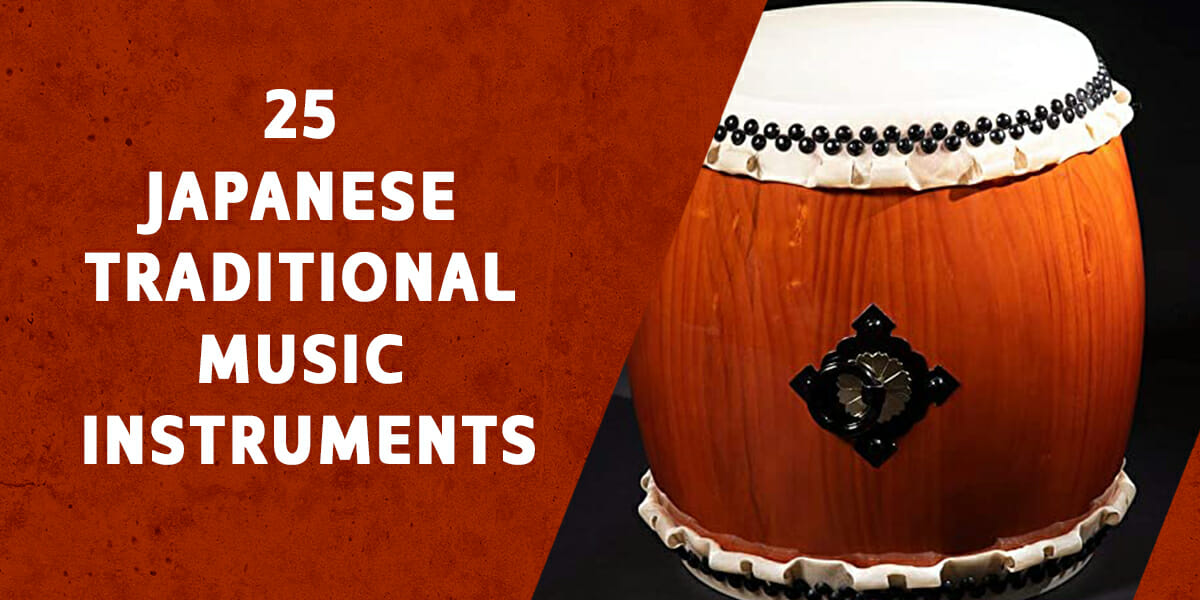
Historically, Japanese music was influenced by the Chinese and Korean music. But being an isolated island nation, Japan has evolved its characteristically distinct music and indigenous musical instruments.
It is quite impossible to explain the novelty and expression of traditional Japanese music in words. Japanese music is significantly different from Western music. It is an interesting learning avenue for passionate musicians.
Are you curious about the Japanese music? Why not get started by learning about these stunning musical instruments?
Table of Contents
Wind Instruments
Fue or flutes are among the most ancient Japanese instruments. There are a variety of bamboo flutes still popular in Japanese music. These flutes are an integral part of festivals, folk music, and theatre in the Japanese culture.
1. Hichiriki
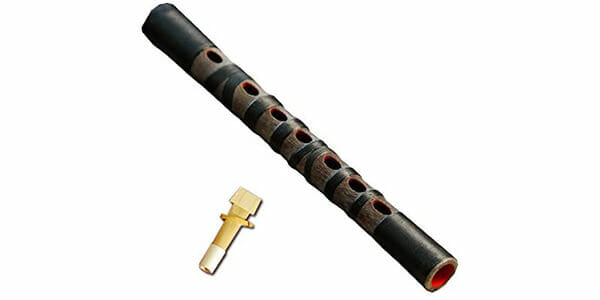
This ancient flute is said to have been introduced in Japan from China. Unlike other Japanese flutes, the Hichiriki is a vertical flute with a double reed. The construction of the instrument is rather simple but impactful, with 9 holes across an 18 cm long body. Although it is made of bamboo hollow, strips of cherry-tree bark are wrapped around the outside surface.
Unusual for its humble size and construction, the Hichiriki can play loud sounds at variable pitch. The instrument is usually played in classical Japanese royal court-style music called gagaku.
2. Shakuhachi
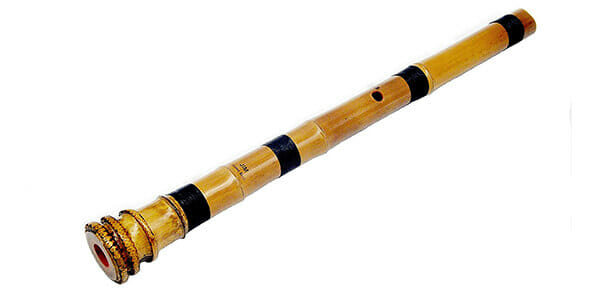
Another popular instrument for gagaku, the Shakuhachi also finds its origin from the Chinese culture. Originally, the Shakuhachi was also made from stones and animal teeth besides bamboo. It was considered as a preferred instrument of the nobles in ancient Japan. The original flute was eventually adopted by Japanese Buddhist monks for prayer and meditation, which greatly influenced the style of playing prevalent now.
Ordinarily, this instrument is 54.5 cm long with 5 finger holes, but there may be longer or shorter versions as well. The inimitable tones and free-style playing has made Shakuhachi popular not only among the Japanese folk singers but also an instrument of choice for maestros.
3. Horagai

Horagai is a shell-conch made from the Japanese spiral shellfish. The mystical sounds from Horagai were originally used during religious chanting and sometimes for sending signals during war.
Horagai’s size can range from 20 cm to 50 cm. The sound is produced by blowing at a mouthpiece attached to the edge of the shell-conch. Variations in sound can be produced by the player’s lips moving in a trembling motion.
4. Shinobue
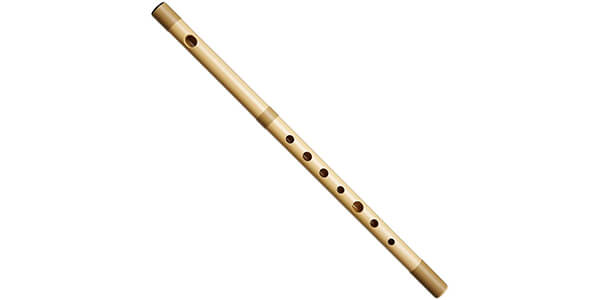
Shinobue is a simple transverse flute which hardly found association with the nobility. Shinobue has largely been a part of folk traditions, festivals and Kabuki music. The instrument’s body is made with a special variety of thin bamboo called medake. Shinobue’s length can vary from 20 cm to 60 cm depending on the increment of keys included for pitch adjustment.
The instrument produces soothing gentle notes which fit perfectly in folk singing and graceful theatrical performances.
5. Ryuteki
This is another traditional Japanese flute which finds its origin in China. In Japanese language, Ryuteki means a “dragon flute” and the sound of Ryuteki is believed to be celestial like the sounds of dragons. The Ryuteki was popular among the nobility as well folk people. The construction of the 40 cm long Ryuteki is quite similar to that of a Hichiriki, though the addition of lead at the end adds a bit of weight to the instrument.
Ryuteki’s sound is just as loud and impactful as Hichiriki, but there is also a distinct melody and grace in the tones.
6. Komabue / Kagurabue

These flutes are adapted versions of Ryuteki presenting alternative sound pitches.
While Komabue has a tone higher than Ryuteki, Kagurabue’s pitch is lower. Komabue is used for producing sharp high notes. Contrastingly, Kagurabue is known for elegant and gentle melodies and is among one of the most expensive Japanese flutes.
7. Sho
Sho is a wind instrument which is made with 17 thin bamboo hollows attached at the base in a cup-like wooden structure. The instrument’s length spans about 50 cm combining long and short pipes. Each pipe has a finger hole at the bottom, which allows the player to create music by blowing out or drawing in air through the pipes. The working is similar to a harmonica and is used for creating chord music. Sho is used in gagaku performances.
8. Nohkan
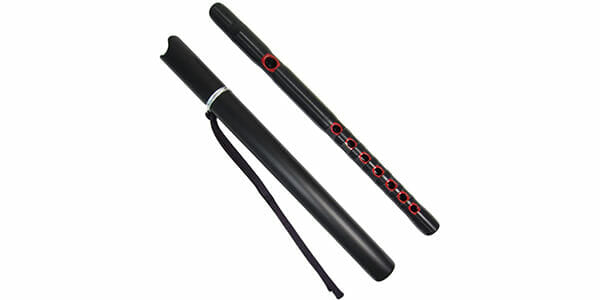
Nohkan is another adaptation of Ryuteki and is used in Noh performances. There is a slight modification in the construction of the Nohkan flute. The slender madake bamboo hollow is fitted with a shorter bamboo pipe just below the blow-hole. This helps in creating a distinct high-pitch sound which is characteristic of the Nohkan.
Nohkan is usually played along with other percussion instruments. It is the heart of the lively music in Kyoto’s popular Gion Matsuri festival.
String instruments
It is believed that string instruments were played only by the nobles and samurai in Japanese history. The common Japanese folk got involved with the string instruments only after the 16th century. As such we can notice that Japanese traditional musical instruments have acquired a detailed and complicated structure, meant to be learnt and played by the elite.
9. Koto

Koto is Japan’s most popular stringed-instrument made with local wood called paulownia. Traditionally the 13 strings of Koto were made with silk-threads, but these days nylon is used. Sliding wooden bridges made of rosewood or ebony, are used for tuning the strings. The player plucks at the strings with his thumb, index and middle fingers to create music.
Koto is played in solo performances as well as a part of an ensemble with other traditional instruments. With the fusion music culture on the rise, we can also find Koto being played alongside western musical instruments.
10. Taisho-goto
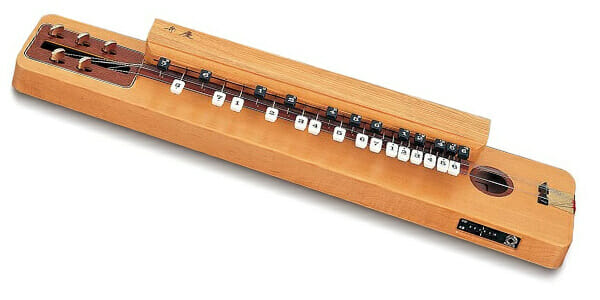
The Taisho-goto is a Japanese musical instrument inspired from Western instruments. It was invented in 1912. The Taisho-goto uses metal strings like a guitar, and has buttons for changing the tone. The instrument can scale upto 12-notes just like western instruments.
The Taisho-goto is easy to play and is used in Japanese ballads, pop music and also kid’s music.
11. Biwa
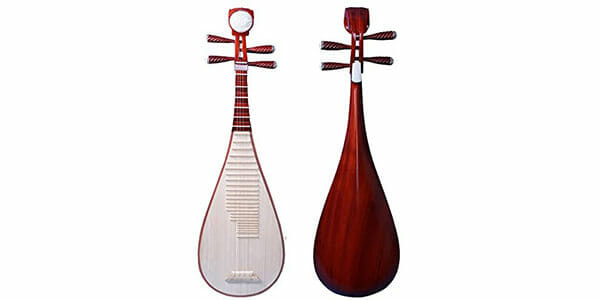
Biwa is a spectacular traditional instrument believed to be of Persian origin, which travelled through central Asia, China and Korea to penetrate the Japanese music culture. The pear-shaped instrument was initially a part of the Japanese court music and was eventually adopted by blind priests for religious narratives and story-telling. Travelling Biwa players called Biwa–Hoshi are credited for the popularity of this instrument.
The size of Biwa can range from 75 cm to 100 cm in length. There is a great variety noticed in the type of wood used including rosewood, ebony, Chinese quince and cherry-wood. Depending on these variations in material and construction, there are about 5 popular types of Biwa. These are Gakubiwa, Heiki Biwa, Mousou Biwa, Chikuzen Biwa, and Satsuma Biwa.
Biwa is now being played alongside western instruments and revived by Japanese musicians into fusion music culture.
12. Shamisen
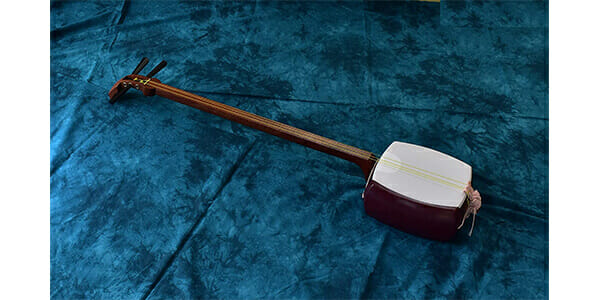
Shamisen is a simple 3-stringed instrument that is relatively recent in the history of Japanese traditional musical instruments. It is known to have originated from the Sanxian region of China and brought to Japan in the 16th century. It is also believed that Shamisen’s current structure was developed by blind Biwa players.
The instrument is made of animal skin stretched over a square body. The musician who plays a Shamisen sits in a kneeling position and plucks at the strings using a plectrum. It is one of the most popular Japanese musical instruments enjoyed for its calm and expressive sounds.
You can hear Shamisen music in many modern Japanese performances and pop culture.
13. Sanshin
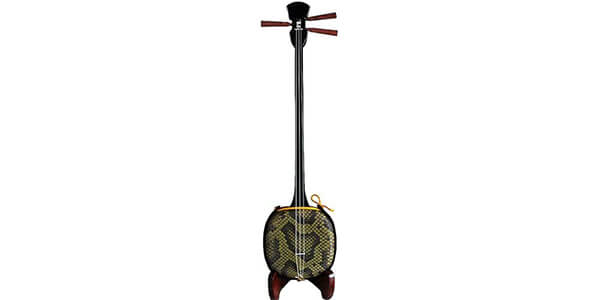
The Sanshin is considered to be the predecessor of Shamisen. The Sanshin originated in China and still uses Chinese characters as notes. The literal translation of Sanshin means three strings. The traditional Sanshin was made with python-skin! The size of the instrument is 80 cm. The instrument is still a part of the traditional music of Okinawa and Amami districts. It can be heard playing in folk gatherings and ceremonies.
14. Kokyu
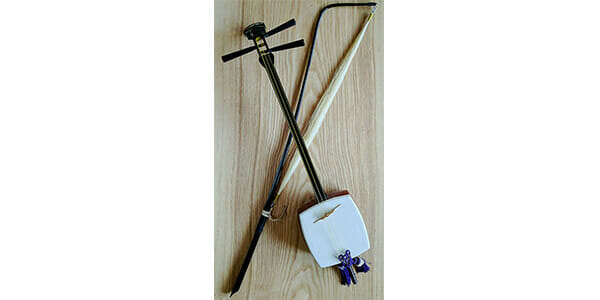
Although it is considered to be an adaptation of the Shamisen, the Kokyu is a unique Japanese string instrument in the sense that it is played using a bow instead of the plectrum. The Kokyu is a part of the Japanese folk music and traditions. Since the size of Kokyu is only 69 cm, it is held between both knees while playing.
The melancholic sounds from the Kokyu find application in Kabuki theatres.
15. Mukkuri
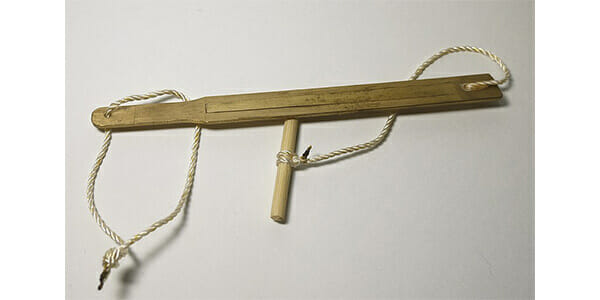
The Mukkuri is a simple hand-held string instrument. The construction of the instrument is very plain and uncomplicated. With just a single string looped across the Mukkuri, it is quite a wonder that music and melodies can be produced. The trick is to place the narrow part of the instrument in the mouth, while plucking at the looped string. It is possible to create variations in the sound of the music using the tongue and mouth movements.
If you are visiting Japan recently, look for this little instrument in the local souvenir shops and have a go at it too!
Percussion Instruments
Just like the other Japanese instruments, percussion instruments are also based on the idea of creating maximum sound effects using minimum materials. It seems that the infinite potential of percussion instruments have been intentionally limited in order to create a concentrated sound effect.
16. Tsuzumi
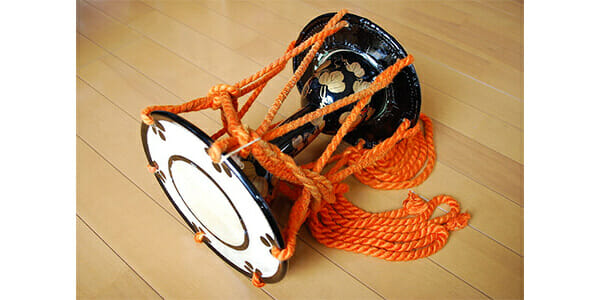
The Tsuzumi is an hour-glass shaped percussion instrument which is believed to have its origin and inspiration in the Indian culture. The Tsuzumi can be small (Kotsuzumi) or big (Sannotsuzumi), its size ranging from 26 cm to 45 cm.
It is an interesting hand-held percussion instrument where the player has the freedom to change the sound pitch by varying the rope tension.
17. Taiko

In the Japanese language, any kind of drum is called a Taiko. As such there are many types of Taiko in Japanese traditional music, the barrel-shaped Taiko being the most popular in folk music. Usually, the sticks used to beat on the drums are made of softwood. Interestingly, the playing technique applies strokes only to a small central area of stretched animal skin.
Some beautiful sound effects can be created using the Taiko. Japanese theatrical performances like the Noh drama use Taiko for producing sounds of wind, rains and snow!
18. Kane
In Japan, if you go looking for a Kane, you would be handed a bunch of metal instruments. That’s because generally any metal percussion instrument is called a Kane in the Japanese language. Kane are hand-held musical instruments used for creating reverberating sounds by striking the centre of a metal plate. Some Kane may be shaken in hand like a gong for creating sound. Suzu, Atarigane and Chappa are the names of commonly played Kane in Japanese festivals and theatres.
19. Kakko
The Kakko belongs to the category of drums played in gagaku and is believed to be originated from China. Nowadays, the Kakko is used in theatrical performances for giving entry and exit cues to performers.
The Kakko is about 30 cm in length and made of oak wood and cherry-wood. The instrument is played with the hands, creating varying sound effects with the tempo and alternating strikes.
20. Daiko
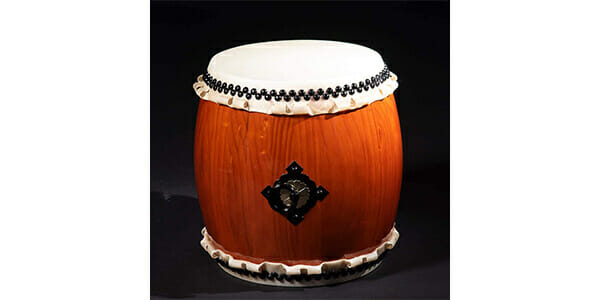
The Daiko is a drum used in gagaku music. The drum is made of animal skin stretched and tightened by ropes on a wooden frame. The drum is beaten on both sides with sticks to produce music. The frame and surface of the drum are painted with ornate designs. Sometimes there may be a flame-shaped ornament around the drum. This Daiko is called a Kaen Daiko. (In Japanese, Kaen means flame).
Daiko is commonly heard being played in festivals and Buddhist rituals and in Japanese rituals.
21. Shouko
Shouko is a small dish-shaped gong (about 15 cm in diameter) hung from a wooden stand. Sound can be created by hitting the inside of the gong with sticks in both hands. The sticks or mallets are made of animal horns, wood or stone. Shouko stands are also ornamental like Daiko stands.
22. Shakubyoshi
The Shakubyoshi is an ancient Japanese percussion instrument with a very simple construction. It is a pair of wooden clappers, struck together to create sound. The Shakubyoshi finds mention in ancient Japanese literature. In historical times, the Shakubyoshi was an instrument for announcing the time.
Shakubyoshi is used in classical music and dance to give rhythmic beats. It is also used for striking sound at determined points during a musical performance.
23. Dora
The Dora is a large metallic gong, usually made with bronze. The origin of this instrument is believed to be in Chinese culture. Dora frames are practical in design and structure without any ornamental detailing. The instrument is usually played in Buddhist prayers, folk arts and theatre.
24. Mokugyo
The Mokugyo is a piece of art as much as an instrument for music. The percussion instrument has a fish-shaped surface. The Mokugyo can be usually seen in Buddhist temples. It is played during chanting and prayers. Similar instruments are used for reciting Buddhist sutras and mantras in other Asian countries including China and Korea.
25. Binzasara
Unlike other Japanese percussion instruments that are made with animal skin, the Binzasara is made of bamboo. Several bamboo slats are beaded together with a string and moved in wave-like motion with both hands to create music. The Binzasara is usually played during folk performing arts.

